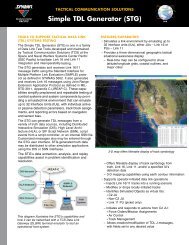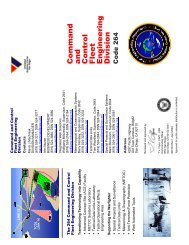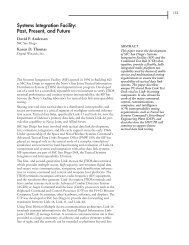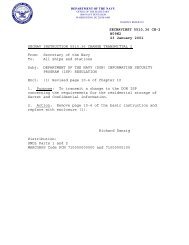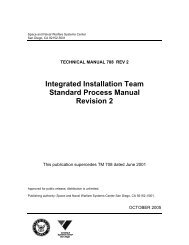Intelligence, Surveillance, and Reconnaissance - Spawar
Intelligence, Surveillance, and Reconnaissance - Spawar
Intelligence, Surveillance, and Reconnaissance - Spawar
Create successful ePaper yourself
Turn your PDF publications into a flip-book with our unique Google optimized e-Paper software.
178<br />
INTELLIGENCE, SURVEILLANCE, AND RECONNAISSANCE<br />
of the discovery <strong>and</strong> invention projects within the<br />
Seaweb Initiative. Feedback from Navy comm<strong>and</strong>ers<br />
indicates that fleet acceptance of Seaweb-based<br />
systems critically depends on the incorporation<br />
of TRANSEC. Achieving TRANSEC as an integral<br />
feature of telesonar-based networking will foster the<br />
extension of Seaweb to cl<strong>and</strong>estine missions <strong>and</strong><br />
stealthy platforms, all of them interoperable with<br />
the aforementioned existing applications.<br />
Compared with traditional point-to-point acoustic<br />
communications approaches, telesonar TRANSEC<br />
inherently derives from the relatively low transmit<br />
power levels <strong>and</strong> high frequencies made feasible by<br />
Seaweb network routing <strong>and</strong> repeater nodes.<br />
Telesonar link-budget analysis [16] is aiding the<br />
design of an evolving Seaweb physical layer incorporating<br />
electronically steered directional transducers<br />
[17], higher acoustic frequencies, increased spectral<br />
b<strong>and</strong>width, spread-spectrum signaling [18 <strong>and</strong><br />
19], <strong>and</strong> power control.<br />
CONCLUSION<br />
Undersea, off-board, autonomous<br />
systems will enhance the<br />
war-fighting effectiveness of<br />
submarines, maritime patrol aircraft,<br />
amphibious forces, battle<br />
groups, <strong>and</strong> space satellites.<br />
Wide-area sensor grids, leavebehind<br />
multi-static sonar<br />
sources, mine-hunting robots,<br />
<strong>and</strong> AUVs are just a few of the<br />
battery-powered, deployable<br />
devices that will augment space<br />
<strong>and</strong> naval platforms. Distributed<br />
system architectures offer maximum<br />
flexibility for addressing<br />
the wide array of ocean environments<br />
<strong>and</strong> military missions.<br />
Transformation of undersea warfare<br />
will result from the ability<br />
of mission planners <strong>and</strong> theater<br />
comm<strong>and</strong>ers to deploy an<br />
appropriate mix of undersea sensors,<br />
vehicles, <strong>and</strong> other devices<br />
from a repertoire of evolving<br />
component systems. Sea power<br />
is achieved through the ability to<br />
match a resource set to the ocean<br />
environment <strong>and</strong> the mission at<br />
h<strong>and</strong>. Robust, environmentally<br />
adaptive telesonar modems<br />
interconnect undersea assets,<br />
OVER-THE-HORIZON<br />
COMMAND CENTER<br />
6 REPEATER NODES<br />
NODE-TO-NODE SPACING<br />
1.5-3.0 km<br />
44°16.5'<br />
44°16'<br />
44°15.5'<br />
44°15'<br />
150<br />
150<br />
175<br />
44°14.5'<br />
150<br />
63°16.5' 63°16' 63°15.5' 63°15' 63°14.5' 63°14' 63°13.5'<br />
KILOMETERS<br />
0 1 2 3<br />
FIGURE 3. The October 2002 RDS-4 Seaweb network in the<br />
Approaches to Halifax supported the RDS-4 Rapidly Deployable<br />
Sensors Trials. Seaweb networking integrated U.S. <strong>and</strong> Canada<br />
experimental autonomous ASW sensors deployed on the seafloor.<br />
Gateway buoys supported FreeWave line-of-sight radio links <strong>and</strong><br />
Iridium satelite links to the shipboard comm<strong>and</strong> center.<br />
Legend: – U.S. <strong>and</strong> Canada gateway buoys; H – U.S. Hydra<br />
HLA sensor; K – U.S. Kelp VLA sensors; U – Canada UCARA<br />
HLA sensors; – U.S. Seaweb repeater nodes.<br />
2 RACOM BUOY GATEWAY NODES<br />
3 AUV GLIDER MOBILE NODES<br />
IRIDIUM SATELLITE<br />
RADIO LINKS<br />
CFAV QUEST<br />
COMMAND<br />
CENTER<br />
FREEWAVE<br />
RADIO LINKS<br />
FIGURE 4. The February 2003 Q272 Seaweb network in the Eastern Gulf of Mexico included<br />
three AUVs, six repeater nodes, <strong>and</strong> two gateway buoys. The experiment exercised Seaweb<br />
ranging functions for tracking <strong>and</strong> navigating mobile nodes. The AUVs proved themselves<br />
as effective mobile gateway nodes with telesonar, FreeWave, Iridium, ARGOS, <strong>and</strong> GPS.<br />
175<br />
K<br />
H<br />
150<br />
K<br />
U<br />
150<br />
U



